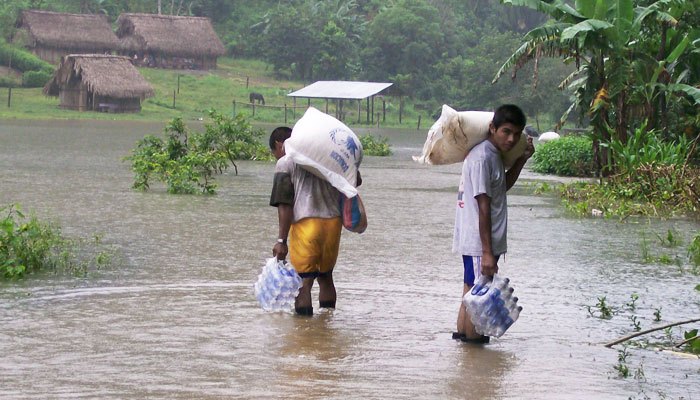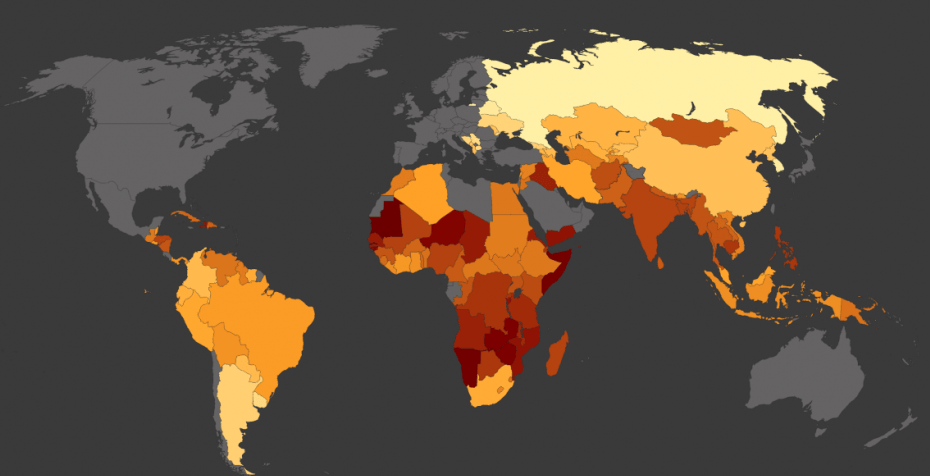Hunger in the time of climate change

As climate change threatens to make world hunger an even graver situation, The World Food Programme is leading the charge to ensure that our most vulnerable populations are protected.
In Maslow’s hierarchy of needs, food is highlighted as among the most fundamental necessities for human survival. However, despite the importance of food, nearly 805 million people today are food insecure while over 2 billion are undernourished [1]. Fortunately, the World Food Programme (WFP), the worlds largest non-profit fighting hunger, operates with an audacious mission to solve this problem. Its primary activities include providing emergency food aid and improving nutrition for vulnerable populations.
While human conflicts can give rise to emergency situations, natural disasters are the leading cause of hunger and malnutrition and are the key drivers for WFP’s services. Consequently, WFP is likely in for its biggest challenge yet due to climate change, which is increasing the frequency of extreme weather events (e.g., droughts, floods, and storms) and longer-term climate risks (e.g., higher temperatures, rising sea levels, changing flood/drought patterns) [2].
There are major implications of climate change on food and nutrition. The effects of rising temperatures have already proven to decrease crop yield as “global maize and wheat production declined by 3.8 percent and 5.5 percent, respectively, from 1980 to 2008”[4]. Changing drought and flood patterns may also further strain crop yield and quality. Decreased yield and quality will lead to lower quantity and quality food for consumption, and reduce farmer incomes. Food scarcity also increases the likelihood of conflict, further threatening food security. Fast forward to 2050 and the situation may become dire. The global population is projected to be 9.6 billion by 2050 [5] while the demand for food is projected to double [6]. All the while prices will rise – with certain staples such as wheat projected to be 40% higher while fruits and vegetables could be up to 30% more expensive, thereby putting food even further from people’s reach [7].
Projecting vulnerability for food insecurity (darker shades) by 2050 assuming emissions are slightly reduced, and with a low level of adaptation
WFP is very aware of the threat from climate change. If it was only to act reactively and provide food aid to those impacted, the costs of such services would likely spiral into several tens of billions a year [8]. It’s therefore crucial for it to focus on proactive efforts and is currently doing the following [9]:
- Analyzing the link between climate change and food security. WFP is modeling the impact of climate change on key food security criteria including availability, access, utilization, and stability, with the intent of informing policy and actions [10].
- Creating early warning systems for disasters to empower governments and communities. Doing so will allow for better preparation and faster response from disasters.
- Helping vulnerable populations diversify their income generation beyond farming. Vulnerable populations that derive most of their income from farming are at risk from climate change shocks. Helping them diversify their income streams lessens the impact of these shocks.
- Developing weather-based insurance and savings programs. For instance, such initiatives offer farmers insurance to compensate them during weather-related losses and eliminate the need for them to sell productive assets out of desperation, thereby returning them to productivity sooner. Farmers first pay for the insurance with their own labor, since most lack sufficient funds, with the intention for them to eventually pay with cash [11].
Assuming the two major levers for lessening the impact of climate change on vulnerable populations is (1) increasing ways for these populations to adapt and become more resilient, and (2) lowering overall emissions, there are additional steps that WFP can take. The organization can further help its target populations adapt by finding innovative and low cost ways to support access to clean water and sanitation that are less impacted by catastrophes. Inadequate sanitation and unclean water can lead to illness and prevent those effected from engaging in productive work to support themselves and their family.
On the topic of lowering emissions, tactically WFP can help farmers adopt more emission-friendly farming practices and their families more efficient lighting and cooking sources. Doing so would lessen emissions, and reduce the instances of farmers depleting soil or families cutting trees for fuel. Perhaps most impactfully, WFP can leverage its forecast data and actual data from operating in the field to make a credible and compelling case for the monetary impact of climate change. It can demonstrate the growing divide between available funding and necessary aid when approaching governments and funders. By advocating for emission reductions with a strong financial case, WFP can ideally help speed up the adoption of emission reducing protocols.
On humanities path to attaining the self-actualization proposed by Maslow, we must first overcome the threat of climate change and ensure access to sufficient food and nutrition for everyone. WFP is leading the charge and through innovation, partnerships, and advocacy can ideally succeed. (798 words)
Sources:
1. USDA, “Climate Change, Global Food Security, and the U.S. Food System,” http://www.usda.gov/oce/climate_change/FoodSecurity2015Assessment/FullAssessment.pdf, accessed November 2016.
2. The World Food Programme, “Climate Impacts on Food Security,” https://www.wfp.org/climate-change/climate-impacts, accessed November 2016.
3. The World Food Programme, “Climate Change,” http://www.wfp.org/content/climate-change, accessed November 2016.
4. The Atlantic, “Food Security and Climate Change: The True Cost of Carbon,” http://www.theatlantic.com/health/archive/2011/09/food-security-and-climate-change-the-true-cost-of-carbon/245608/, accessed November 2016.
5. USDA, “Climate Change, Global Food Security, and the U.S. Food System,” http://www.usda.gov/oce/climate_change/FoodSecurity2015Assessment/FullAssessment.pdf, accessed November 2016.
6. World Economic Forum, “How will climate change affect food security?,” https://www.weforum.org/agenda/2015/12/how-will-climate-change-affect-food-security/, accessed November 2016.
7. ThinkProgress, “Our Future May Hold Less Food, Thanks To Climate Change,” https://thinkprogress.org/our-future-may-hold-less-food-thanks-to-climate-change-b78cff2b0e48#.brjoeitsh, accessed November 2016.
8. The Guardian, “Climate talks: 4C rise will have dire effect on world hunger, UN warns,” https://www.theguardian.com/global-development/2015/dec/01/climate-talks-4c-rise-dire-effect-world-hunger-un-warns, accessed November 2016.
9. The World Food Programme, “Climate Change,” https://www.wfp.org/climate-change, accessed November 2016.
10.The World Food Programme, “Climate And Food Security Analyses,” https://www.wfp.org/climate-change/innovations/analyses, accessed November 2016.
11. The World Food Programme, “The R4 Rural Resilience Initiative,” http://www.wfp.org/climate-change/initiatives/r4-rural-resilience-initiative, accessed November 2016.





Great post Saksham! I agree that food shortage is an extremely important issue and will be affected by climate change. I also think that all the programs the WFP is enacting can spark significant change in reducing hunger across the world. That being said, I do wonder how well the WFP will be able to implement these programs given that the countries in most need will oftentimes have the least developed infrastructures and government responses. I saw that the WFP has partners across the public and private sector (http://www.wfp.org/partners)- which avenues do you think are the most effective?
This is fascinating, Saksham. WFP is one of the only organizations that is positioned to to enable change across countries and organisations. I hope that they communicate the message from the model they are building on the link b/w climate change and food security – it is something governments are interested in, and there are few credible sources with this information. On the early warning systems, however, I am curious if they are working with other agencies to build this? It does not seem like their core competency.
Saksham, thank you for your post, this is a topic I’ve been interested in for years. A couple incremental thoughts and observations. As you mentioned, the scarcity of food is going to not only be exacerbated by climate change and weather patterns, but also by a rising global population that will put increasing stress on the system. Water, food, and population are all intricately linked as one might expect – but another element of this is that livestock, which serves as food for humanity, also consume a disproportionate amount of water. I came across a TED talk a couple years back on a Company called Modern Meadows – I recommend taking a look at it (I think the stat they have in the video is that in order to sustain a global population of 10 billion, we will require 100 billion animals / livestock). The Company started by trying to find ways to 3D print synthetic leather that had the same look and feel of the real thing. From there, they are trying to do so with meat. I think their technology, and others like it, could have a huge impact on this global issue in the future.
Saksham, I really enjoyed your post. I would argue that this is one of the most serious causes that we need to be concerned about as it relates to climate change. People in third world countries are not in the economic position to combat the affects of climate change and we’re doing very little to protect them. The countries that are in the most risk will need to have stronger economies to handle this situation or the world’s more advanced countries will need to be in a position to supply a large amount of humanitarian aid. This is a current problem that we should be very actively working on or millions of people could die.